The Arlington Microgrid Project’s V2G Technical Specification vs Standards
Written by Charlie Vartanian, Scott Gibson, Siddharth Sridhar, Hawk Asgeirsson, and Ryan Franks
The Snohomish Public Utility District's (SnoPUD) Arlington Microgrid project includes a Vehicle-to-Grid (V2G) demonstration. This article summarizes the Arlington project and motivations to demonstrate V2G. The article compares key aspects of the project's V2G technical specifications versus V2G-related standards available or being developed by the Institute of Electrical and Electronics Engineers and the Society of Automotive Engineers. This project's early V2G deployment and demo will inform future efforts to define and specify technical capabilities for V2G products and projects. The use of industry published standards, as they become available, will reduce the need for custom case-by-case engineering and thus lower barriers to implementing and using V2G-capable products and projects in microgrids and 'smart' grids in general.
Introduction
Snohomish County PUD (SnoPUD) has recently commissioned the Arlington Microgrid (AMG). This project employs state-of-the-art technology to demonstrate the multiple uses of energy storage (ES), renewable energy integration, and electric vehicle (EV) integration. When connected to the grid, the system will send power generated by the 500-kilowatt solar array on site to SnoPUD customers. When the microgrid is “islanded” and independent from the grid, AMG will demonstrate resiliency by providing electricity to critical SnoPUD facilities, in the event of a storm or natural disaster.
These are the major the components of AMG:
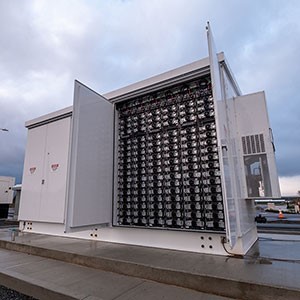
Figure 1 - BESS at AMG
The 1 MW/1.4 MWh Li-ion BESS is powered by the on-site solar array.
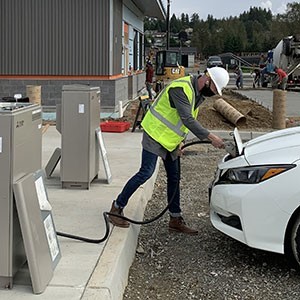
Figure 2 - V2G Charging at AMG
These two V2G chargers along with compatible EV’s allow SnoPUD vehicles to not only receive a charge, but flow power back to the grid.
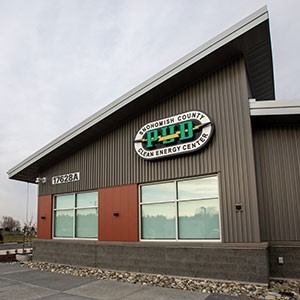
Figure 3 - Clean Energy Center at AMG
This multi-use facility will use interactive exhibits and displays focused on renewable energy, battery storage and energy efficiency.
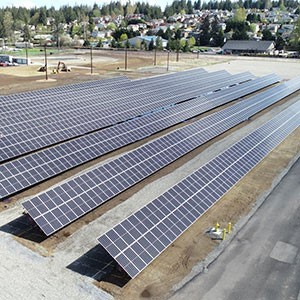
Figure 4. Community Solar at AMG
AMG’s 500 kW PV array provides clean energy to power the BESS, plus it provides solar power to SnoPUD’s Community Solar program subscribers.
To help fund the project, SnoPUD was granted $3.5 million from the Washington State Clean Energy Fund, covering a portion of project costs. Additional analytic support was provided technical staff from the Pacific Northwest National Laboratory (PNNL) located in Richland WA. PNNL’s analytic support was focused on the V2G portion of the microgrid’s scope. One topic investigated by PNNL staff was the potential to use technical standards in place of the extensive custom engineering required at major project phases of AMG’s V2G system.
At the time of AMG project’s award, V2G technology was very new to the industry. Thus, most of the technical requirements for AMG’s V2G demo could not reference published standards. However, since that time IEEE and other Standards Development Organizations (SDO’s) have made advances in developing standards that include content specific to V2G, or are relevant to V2G.
The rest of this article compares the specifications of the AMG’s V2G scope to existing standards, discusses a coordinated effort across power and automotive industry SDO’s, and then highlights the importance of establishing Codes & Standards (C&S) to reduce the cost and complexity of adopting advanced and emerging technologies like V2G.
Arlington V2G Technical Specification Mapped to Standards
For relatively mature technologies like Arlington’s BESS and PV, the power industry has established practices that apply standards to help assure projects deliver minimum acceptable performance, reliability, and safety. However, V2G technology is not yet at a mature stage of industry adoption and use; thus, there are not yet adopted industry standards to support early V2G projects. To help fill this gap, SnoPUD’s AMG project provides a useful reference point. PNNL staff reviewed SnoPUD’s procurement specification vs standards. The result of the review is Table 1 mapping V2G equipment performance requirements versus potentially applicable standards.
Table 1 - Selected Performance Capabilities, Associated Specifications, and Standards
| Equipment Performance Requirement | Specifications | Potentially Applicable Standards | |
| Power Ratings and Interfaces |
Power Rating, KVA Ampacity, A Voltage, V |
“CHAdeMO 1.0 and Combined Charging Systems (CCS) level 2 DC charging standards” |
SAE International (formerly Society of Automotive Engineers) has standards that set power capacity for various defined charging levels. These include SAE J1772 [1] For AC voltages, ANSI. C84.1 for nominal and allowable ranges. Can apply to both charging (AC supply to load) and discharging (AC output by resource). |
| Interoperability Capabilities & Interfaces |
Communication Transport Layer(s) Communication Protocol(s), Minimum/Required Information Content Cyber security |
“The V2G Solution must support communication standards, such as IPv6, 802.15.4e and 802.15.4g.” IEEE 1686-2007 Security for Intelligent Electronic Devices (IEDs) NERC CIP 002-009 Cyber Standards for the bulk power system NIST Special Security Publication SP 800-53 & NIST SP 800-82. Cyber Security Standards and guidelines for Federal Information Systems for application in Bulk Power System FIPS140-2 Security Requirements for Cryptographic Modules |
IEEE 1547 [2] for discharging (resource). 1547 cites TCP/IP over ethernet and RS-485 IEEE 1547 for discharging (resource). 1547 cites Modbus, IEEE 2030.5 (SEP2) [3], and IEEE 1815 (DNP3) [4] MESA-Device [5], Sunspec Modbus models None in addition to the spec’s list. |
| Interconnection Requirements |
General Anti-Islanding VAR capacity and voltage control modes Grid Disturbance Ride Through |
“Operation of the V2G charger(s) shall not interfere with the facility’s overall compliance with Interconnection Requirements at the PCC” |
IEEE1547 for discharging (resource) IEEE1547 for discharging (resource) IEEE1547 for discharging (resource) |
| Power Quality |
Harmonic Limits Maximum temporary overvoltage or undervoltage |
“Operation of the V2G charger(s) shall not cause degradation of power quality when operating (e.g., measurable harmonic injection must be within IEEE 519 limits)” |
IEEE 519 [6] for charging (load) IEEE 1547 for discharge (resource) IEEE 1547 for discharge (imparted by resource) Information Technology Industry Council voltage curve for charging (load withstand capability) |
| Other |
Fire Safety Grounding Metering Arcflash and associated energy and PPE levels Recovery, Reuse or Recycling at end of life |
UL 9540 and UL 9540A, if the V2G charger has integrated stationary storage IEEE 142 IEEE 1377 IEEE 1584 NFPA 70E Unknown, possible industry gap |
While none of the cited standards in the table are specific to V2G, it is useful to note that many existing and established standards as listed above can be applied to V2G products and projects now. Thus, in the interim, while best practices are being identified and documented for future standardization of V2G equipment and application, there are existing general standards that can be applied to improve the efficiency and success of V2G projects. One active example of leveraging existing grid IEEE standards for V2G is SAE’s work to coordinate their industry’s V2G-related standards with relevant IEEE standards for both onboard and outboard charging equipment. This will be discussed next.
Coordinated Effort To Develop V2G Standards
SDO’s that develop standards for the electric power system (EPS) and automobile need have begun efforts to coordinate standards development. For example, the IEEE develops standards for the EPS and SAE that develops standards are coordinating in their various working groups so that standards pertaining to V2G are harmonized. This coordination will also support organizations such as Underwriters’ Laboratory (UL) to develop testing and certification tools that allow V2G products to be tested and listed.
North American Charging Standards, Light and Medium Duty
Three light- and medium-duty EV charging connectors/couplers standards exist in North America: The Tesla connector (exclusively for Tesla vehicles), CHAdeMO, and combined charging system (CCS). There are also other EV charging standards for transportation buses and medium/heavy-duty trucks not discussed in this article.
The Tesla connector is presently not V2G-enabled. The CHAdeMO standard, used in North America by Mitsubishi and Nissan, has the capability for bidirectional energy flow. However, the CHAdeMO standard connector is being phased out in North America. This means that future non-Tesla mass manufactured light-duty EVs will likely use the CCS standard.
The CCS charge coupler is defined by the SAE J1772 Standard that specifies general requirements for conductive charging of EVs in North America. The electrical ratings for the SAE J1772 are shown in Table 2.
Table 2 - Electrical Ratings for SAE J1772 Conductive Charge Coupler
This standard includes communication between the EV and EV supply equipment (EVSE, e.g. charging station) required for the onboard inverter function to be configured and authorized by the EVSE for discharging at a site. The SAE recommends IEEE 2030.5 as a communications protocol.
In 2021, SAE J3072 [7] was updated to include the requirements that an EV with bidirectional onboard inverter must meet in IEEE 1547-2018. With this recent update of SAE J3072, an EV with an onboard bidirectional inverter and a bidirectional charging station can comply to IEEE 1547-2018, and could be compliant to IEEE interconnection standards while performing V2G operation. See Figure 5 for a simplified illustration.
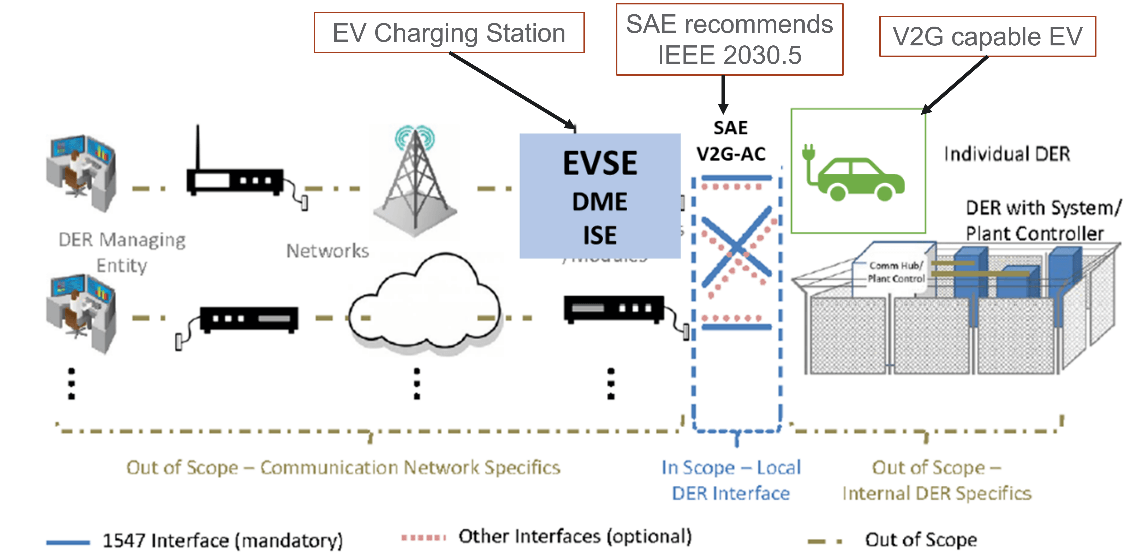
Figure 5 - System Diagram for EV and Charging Station
Impact of Codes & Standards (C&S) Development on Technology Adoption
Gaps in C&S development can lead to a variety of impacts:
- Poorly written standards can be overly restrictive.
- Industries or manufacturers seeking to obtain exemptions from codes can erode adoption as jurisdictions amend certain sections or, in some cases, the entire code.
- Financial providers charging risk-premium cost adders have difficulty pricing risk, or are unable to provide financing at all.
On the other side, C&S with requirements having consensus from stakeholders can:
- Foster the deployment and use of emerging products and technologies.
- Improve safety and reliability.
- Help establish customer and user trust.
In addition, C&S are developed to address unclear or conflicting requirements.
Conclusions
Early demonstration projects including SnoPUD’s Arlington microgrid project will inform development of C&S that will in turn support streamlining of future planning, design, deployment, and operation of V2G technology and projects within smart grids and smart cities.
The technical work discussed in this article was supported by funding from the Department of Energy, Office of Electricity, Energy Storage Program.
References
Selected references with particular relevance to design and implementation of V2G are listed below.
- SAE J1772 Standard for Electric Vehicle and Plug in Hybrid Electric Vehicle Conductive Charge Coupler, https://www.sae.org/standards/content/j1772_201710/
- IEEE 1547-2018 Standard for Interconnection and Interoperability of Distributed Energy Resources with Associated Electric Power Systems Interfaces, https://standards.ieee.org/ieee/1547/5915/
- IEEE 2030.5-2018 Standard for Smart Energy Profile Application Protocol, https://standards.ieee.org/ieee/2030.5/5897/
- IEEE 1815-2012 Standard for Electric Power Systems Communications-Distributed Network Protocol (DNP3), https://standards.ieee.org/ieee/1815/5414/
- MESA-Device specification, Modular Energy Systems Architecture (MESA) Alliance. http://mesastandards.org/mesa-device/
- IEEE 519-2014 Recommended Practice and Requirements for Harmonic Control in Electric Power Systems, https://standards.ieee.org/ieee/519/3710/
- SAE J3072 Standard for Interconnection Requirements for Onboard, Grid Support Inverter Systems, https://www.sae.org/standards/content/j3072_202103
This article was edited by Jorge Luis Angarita.
To view all articles in this issue, please go to May 2022 eBulletin. For a downloadable copy, please visit the IEEE Smart Grid Resource Center.





To have the Bulletin delivered monthly to your inbox, join the IEEE Smart Grid Community.
Past Issues
To view archived articles, and issues, which deliver rich insight into the forces shaping the future of the smart grid. Older Bulletins (formerly eNewsletter) can be found here. To download full issues, visit the publications section of the IEEE Smart Grid Resource Center.




